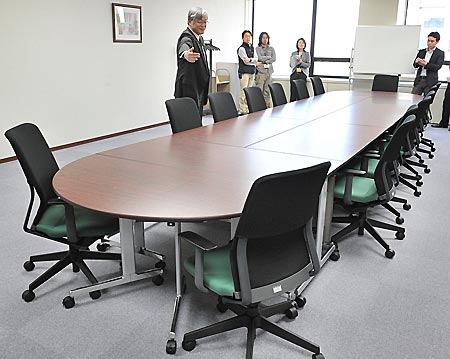The Kanji Aptitude Testing Foundation (KAT), the English name of the Nihon Kanji Nouryoku Kentei Kyoukai, has been in the news over the past weeks for “improper business practices” and high salary and retirement allowance payments to the officers of the board. Like many such scandals in Japan, the matter is partly one of fraud — but the foundation is also a victim of its own wild success, and is a case study in the perils of ignoring gyousei shidou “advice” from the government, and falling victim to the authorities in Livedoor-esque Takafumi Horie style.
KAT is not a kabushiki kaisha (K.K.) private stock corporation, but a zaidan houjin, the oldest and most basic form of the non-profit incorporated entities in Japan roughly translated as “foundation.” It has no members or shareholders, no distributions of profits, and it has no owners, only officers of the board that operate the foundation’s business. (Due to recent reforms, all foundations must now add a board of trustees to act as quasi-shareholders that elect officers). The foundation is not alone in its governance structure. Other similar types of corporations are the shukyou hojin (religious corporation), gakko hojin (school corporation), iryou hojin (medical corporation), and other entities that are the corporate form of ownership and operation for churches, temples, shrines, schools, universities, trade schools, hospitals, elder care centers, and many more of the ordinary institutions of civil society.
But what are these entities to do when they are well managed? Are they to accumulate large cash reserves? The salaries of the board of directors can be raised to an extent, but the officers cannot share in the profits. And for many years, it has been an accepted practice that “non-core” activities of these non-profit corporations can be outsourced to private companies. Hospitals are supplied and consulted, schools recieve their books and other services, and temples buy their incense, from these outside private corporations. Typically, it’s kabuki-style theater of maintaining nominal non-profit status — the private corporations are tyically owned and operated by the very same directors of the non-profit corporation.
(To see one very public example of how this is accepted as legitimate, check out the Japanese web page of the Aso Group, the conglomerate owned and operated by PM Aso’s younger brother, and click the “healthcare” sector. Several hospitals and care centers in Kyoto and Fukuoka are affiliated with the private Aso Group but are non-profit iryou houjin or shakai fukushi houjin. But these entities are listed as secondary to “K.K. Aso Group – Medical Operations Development Department,” “Aso Care Services K.K.”, “Aso Medical Services K.K.”, and other Aso Group entities that manage all non-medical practice services of the hospitals and which are used to extract profit from the hospitals which are required to be non-profit by law.)
KAT issues some of the most popular kanji chinese character tests taken by the citizenry in Japan. Test takers would take certain levels of the test to prove their aptitude in understanding, writing and reading the characters. The tests were wildly popular, such that the group developed plump bank accounts such that it began outsourcing services, such as printing of the tests, to K.K. Oak, owned by Mr. Okubo, the chairman of the board of KAT. Oak subsequently gave off benefits to its subsidiares, which included Okubo family members. The other list of grievances are relatively minor — about 9 million yen (US$90k) was given to various politicians, and about 3 million yen to a temple in Kyoto.
I can report to readers from experience, having reviewed the structures and books of a number of non-profit foundations, school corporations, and medical corporations, that this level of minor fraud is standard operating procedure. Of the thousands of private schools and hospitals operated as so-called non-profit entities, many engage in nepotistic, family-favoring practices that make KAT look minor. But KAT made two big mistakes that brought its operations under scrutiny.
* It ignored a decade of gyousei shidou guidance from the Ministry of Education. Thirteen times, between 1999 and 2007, the Ministry instructed KAT to lower its fees for the top-level course by 500 to 1,000 yen. It also instructed that Okubo should resign as representative of printing house Oak and loosen the ties between the two organizations (KAT rented its main building for US$1.8 million a year from Oak, yet another way in which Okubo profited from the structure).
* It was too profitable. KAT was run the same way plenty of trade schools and hospitals are run, and in my own professional experience, I’ve seen far more dodgy schemes of fraternal profiteering from allegedly non-profit corporations. However, KAT’s tests became a national craze. With its popularlity came wild profits. And with profits came scrutiny.
I know Adamu will SLAM me for using the word “kabuki” in this post, and I could take the cliche train another stop and talk about the nail that sticks up gets hammered down. But as loathe as MF is to those types of analogies, we are seeing instances where they are basically true, where the authorities selectively target only the successful rulebreakers. KAT got screwed in the same way as Horiemon back in 2007. (And on that note, I share Horie’s sentiments recently publicly expressed, and noted here, that he was only targeted because he was a successful rebel, or in other words, that he made the two big mistakes itemized above.) It seems unlikely that KAT will survive in its present form as this scandal continues to spread, and this may be a chance for some of the competitor tests to gain a share of the market. But the two lessons for this for every businessman engaging in the soft fraud that is part of tax, accounting, business, and audit in Japan, make sure that you (1) pay attention to any advice given to you by the government, even non-binding advice, and (2) be ready for the increased scrutiny that will come when you’re profitable. Don’t make the mistakes of Horiemon and KAT.



